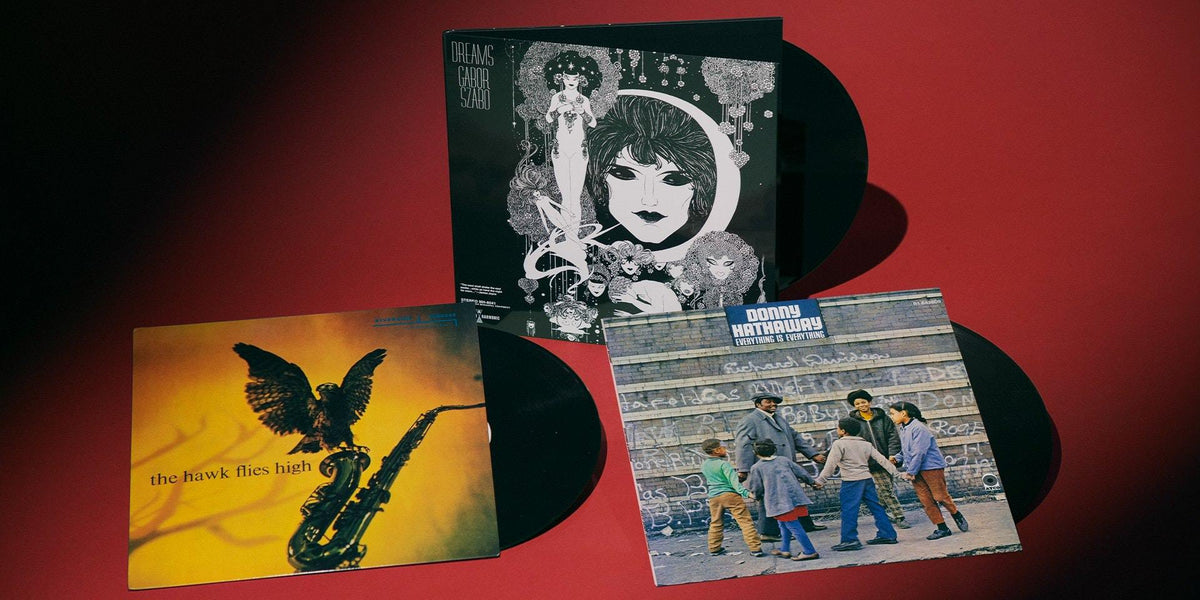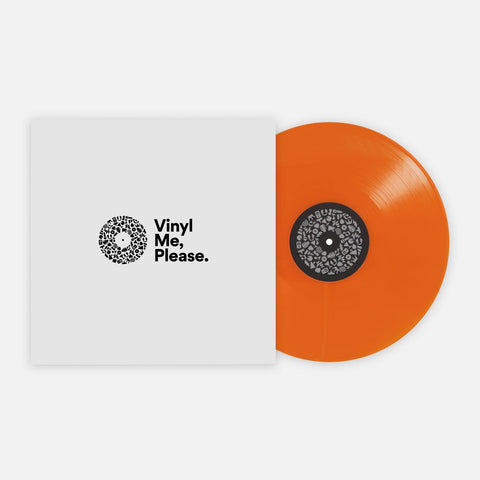Coleman Hawkins Was Jazz’s Bridge To The New
Read The Liner Notes For Our New Reissue Of ‘The Hawk Flies High’
If the blues defined popular music of the 20th century, Coleman Hawkins — born four years into said century, and largely fueled by that 12-bar form — was nearly as undeniable a constant through its first half, if a less heralded one.
It’s a consistency that’s only really possible to see in retrospect, since his contemporary popularity ebbed and flowed: This record, The Hawk Flies High, cemented something of a comeback upon its release in 1957, when Hawk was 52. As more and more jazz subgenres emerged, nostalgic aficionados became increasingly aware of and reverent toward the music’s rich history — to which Hawk was, of course, central. The Missouri native is generally credited with establishing the tenor saxophone as a jazz instrument, but he was playing the music when jazz was “jass” alongside blues singers like Ethel Waters, and Mamie and Bessie Smith.
Based on his lengthy resume alone, you could hardly ask for a better “trad” artist than Hawkins. Yet he resisted the worship of the moldy figs, refusing to hew to their idea of the music as crystallized in some imagined late-’20s, early-’30s heyday. He’s known more as a cornerstone than an innovator, but as this record shows, Hawk deftly navigated the post-bebop jazz world, neither dramatically changing his style nor remaining stuck in his (first) glory days.
The fans, though, often thirsted for something more starkly different — especially as the growing popularity for rock and R&B thrust jazz into the realm of connoisseurs, who were apt to have strong opinions about not just records, but the genre as a whole. “Dated Sax Is Still Good” admitted one 1955 Washington Post headline for a piece about Hawkins recordings, which were starting to be reissued on the then brand-new LPs. From far away, bebop looked like a stark left turn from the danceable swing on which Hawkins had built his storied career, both with his own groups and alongside groundbreaking bandleaders like Fletcher Henderson and Count Basie; few would argue that Hawkins wasn’t the best, but at the same time, young tenor players with brasher, more searching sounds threatened his place atop the mountain.
Hawkins didn’t see it as such a dramatic shift, though — which, counterintuitively, helps explain how he himself became part of the early push toward a more expansive and urgent vision of the music. In 1939, he returned to the U.S. after five years touring Europe and was frankly disappointed by what he saw and heard. “By the time I came back, I thought the musicians here would be much farther advanced,” he said on the 1956 LP A Documentary (The Life And Times Of A Great Jazzman, Newly Recorded In His Own Words). “But they were just like when I left, and saying nothing. Hadn’t advanced anything, hadn’t done anything.”
So he took things into his own hands with a move that he always insisted was completely unintentional: a three-minute long recording of “Body And Soul,” a song he didn’t even particularly like and mostly played when he was trying to get offstage. He only recorded it at the behest of his producer, and yet the result became his signature — even earning him the moniker “The Body and Soul of the Saxophone.” Hawkins was well known as a balladeer by that point, but this was different — his dense, extended solo strayed far from the melody in a way that, logically, would have been somewhat shocking to the average listener at the time.
Still, it became popular as a single (then as now, something of an anomaly for an instrumental jazz track) even as it pushed jazz’s limits ever so subtly. Hawk said over and over that that was how he’d always played it — which is to say, never the same way twice. The October 11, 1939 issue of Variety — published the same day he recorded the song — reviewed a set by his band and specifically mentioned “Body and Soul,” explaining that he was “playing chorus after chorus and no two alike.” An uncertain review from the Washington Post explained that “his solo dominates the record from almost the first phrase to the last, and every phrase is unusual.” “It was supposed to be that way that time, that’s all,” Hawk concluded, nonplussed, on Documentary.
“When ‘Body And Soul’ first came out, everyone said I was playing wrong notes,” Hawk continued. “It used to be funny to me — I couldn’t understand that.” He wound up getting the last laugh, setting the stage in his own way for the beboppers to come. “Body and Soul” was just the start, as he brought people like Dizzy Gillespie, Don Byas, and Thelonious Monk into the studio for their very earliest sessions, proving without pomp that his ears were open and he was anything but stuck in the past — even if he might never have been fully claimed as a bebop figurehead.
To him it was all of a piece, just variations on a jazzy, swinging theme. “It’s not too much strain to play — a couple off notes and you got it made,” he said of “modern jazz” on the same 1956 recording. “Today you can add a few more, now that the ear has been listening.”
Hawkins didn’t add too many “off notes” on The Hawk Flies High — his sole outing produced by the legendary Orrin Keepnews for Riverside — but cast the album in a way that reflected his sensitivity towards his place in the canon as well as in respect to the next generation. Trombonist J.J. Johnson, trumpeter Idrees Sulieman, pianist Hank Jones, and bassist Oscar Pettiford were all between one and two decades younger than him and staunchly in the bop school; guitarist Barry Galbraith and drummer Jo Jones had, like Hawk, spent decades with swing bands.
Together, they combined their expertise for a straight-forward exercise in hard bop; there’s very little of bebops’s feverish urgency, but the all-star group of players still stretches beyond the small-group swing Hawk was known for. The album’s grooves feel vintage for their familiar solidity, but the arrangements have a contemporary, light touch — occasionally even feeling like the kinds of afterhours jam sessions Hawk never stopped frequenting, even as he became one of the genre’s elder statesmen. Technology enabled that casual feel: you can’t stretch out over an 11-minute blues, the way this band does with Sulieman’s composition “Juicy Fruit,” on a 45 or 78. Finally, thanks to the LP, there was a recorded medium well-suited to Hawkins’ endless gift for invention.
That track gets a little weird almost right off the bat with Sulieman sustaining a single note for nearly a minute (or two choruses) using circular breathing, pushing the effortless swing into something more challenging and abstract. It’s a memorable example of how musicians were beginning to try to stretch boundaries even further with their playing, which Hawk made space for even when he didn’t necessarily do it himself. Instead, his meaty tone helps him dig into some well-timed, visceral squawks — very nearly echoing the era’s R&B sound.
The noirish “Think Deep,” a piece written by Third Stream (the name given to artists who self-consciously blended jazz and classical music) composer William O. Smith, is one of the best Hawk showcases on the album. He leans into the movie soundtrack vibe with sensuous, languid riffs, but without receding into the background — instead, he spends the entire song mining deeper and deeper emotional depths. It’s followed by the standard “Laura,” the kind of breathy, murmuring ballad Hawk had long done so well. It’s tender but never sentimental, as the saxophonist flaunts his virtuosic range in a way that’s somehow entirely sincere.
“Chant” and “Blue Lights” (the former composed by Hank Jones and the latter by Gigi Gryce) are almost two sides of the same coin: The first is all bright, uptempo swing leftover from the bebop era, and the latter digs into a funkier two-feel that would become characteristic of hard bop. Finally, “Sancticity” — a Hawk original that’s about as close as Count Basie as you can get without being Count Basie — brings back small-group swing with a winking modern feel. It’s Hawkins playing on his home court, as the younger guys have a slightly harder time saying something compelling within the straight-ahead confines of the tune.
In short, it was an album made by a man who really shouldn’t have had anything to prove but did — who slyly showed that he’d been ever so slightly ahead of the curve the whole time, without ever making too big of a fuss about it. Hawk had already lived through several waves of innovation in jazz, and would live through several more without really dramatically changing his style. He recorded with Thelonious on Monk’s Music a few months after this session, and eventually with Max Roach and Abbey Lincoln on We Insist!, shifting his sound just enough to hang.
Few people had witnessed more of what would become jazz history to that point than Coleman Hawkins; fewer still had survived it literally and figuratively, and this album proved that Hawk was very much alive both as a man and as a musician. “Where there’s good musicians, you’ll always find me,” he said of his hangs with the young boppers on Documentary. “That’s all I’ve ever been used to.
“I don’t think about music the way other people think about it, I guess,” he concluded. “I don’t think about music as being new or modern or anything of the type. You just play.”
Natalie Weiner is a writer living in Dallas. Her work has appeared in the New York Times, Billboard, Rolling Stone, Pitchfork, NPR and more.
Related Articles
Join the Club!
Join Now, Starting at $36Pages





